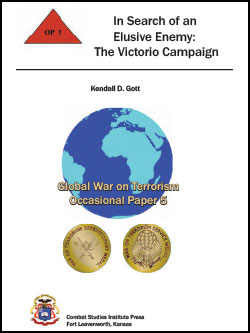
The Victorio Campaign
By Kendall D. Gott
64 Pages
Published: 2004
In Search of an Elusive Enemy: The Victorio Campaign, 1879-1880 represents another in a series of military case studies published by the Combat Studies Institute (CSI) at Fort Leavenworth, Kansas. This work examines the US Army’s efforts in tracking down Victorio, the infamous Apache chief who raided large tracts of New Mexico and Texas at will, terrorizing the entire region. The key point made in this work is that it demonstrates the challenges of tracking and capturing or killing a small, irregular group of warriors in inhospitable terrain and among an alien culture.
Although set in the late 19th century, this case study is still extremely relevant for today’s Army. The commanders of the 9th and 10th US Cavalry Regiments faced a skilled adversary who used unconventional tactics and methods as well as an international border to seek sanctuary. However, it could just as easily have featured the stories of Osceola, Aguinaldo, Pancho Villa, or Osama bin Laden. The similarities to challenges that US and coalition forces face in Afghanistan and Iraq are striking. The commanders of the 19th century faced enormous challenges in the rugged terrain of the American Southwest as well as a skeptical and often hostile press. Again, officers and soldiers who have recently served in Afghanistan and Iraq will certainly see parallels here.
As the US Army continues its efforts in combating terrorists where they live, the lessons found in this narrative are well worth revisiting.
Download the PDF 